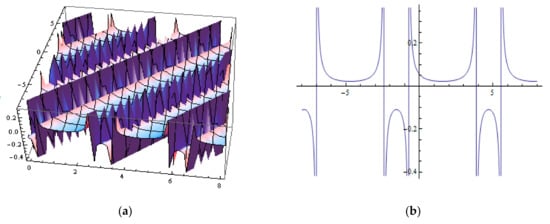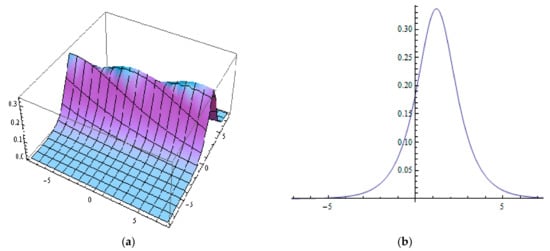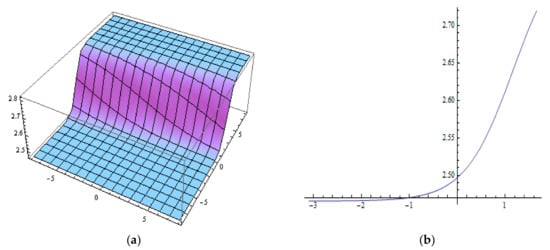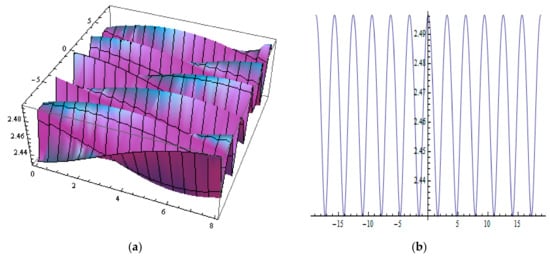Abstract
The nonlinear perturbed Schrödinger equations (NPSEs) with nonlinear terms as Kerr law, power law, quadratic-cubic law, and dual-power law nonlinearity media play an important role in optical fibers. In this article we implement the rational solitary wave method to study the NPSEs when nonlinear terms take some different forms. Additionally, we use the q-deformed hyperbolic function and q-deformed trigonometric function methods to study the exact solutions to NPSEs. Different kind of soliton solutions are obtained such as bright, dark, and singular periodic solutions to the NPSEs.
1. Introduction
In recent years, the research of optical (bright, dark, and singular) solutions for nonlinear Schrödinger equations have played an important role in nonlinear optical media. The optical pulses in the optical solutions play a significant role in communication systems, optical fibers, and so on. Many authors have discussed the optical solutions for the nonlinear Schrödinger equation (NSE) when the nonlinear terms are Kerr law, power law, parabolic law, dual-power law, saturating law, exponential law, higher order polynomial law, and triple-power law (see [1,2,3,4,5,6,7,8,9,10,11,12,13,14,15,16,17]). There are several previous studies which are of great interest in the optical solitons (see [18,19,20,21,22]). Ma et al. [23,24] have discussed exact solutions to NSEs and Lump solutions to higher order rational dispersion relations. Additionally, Ma [25] has provided better approximations to real physical nonlinear waves, which could exist in even linear wave models. Recently, Arshed [3] studied the exact solution for perturbed Schrödinger equations by using the expansion function method.
In this research, we use the rational solitary solution methods and q-deformed functions methods for the following nonlinear perturbed Schrödinger equation [2,3,4,7,8,9]:
where represents the linear evolution phenomena, is dispersion velocity, is the nonlinear term coefficient, is the temporal dispersion, is the self-steepening perturbation term, is the coefficient of nonlinear dispersion, and is the power of nonlinear terms. We will ansatz the traveling wave transformation as
where is the amplitude real function of the wave solution, is the soliton velocity, is the frequency of the soliton, is the wave number, and the phase constant is . Equation (2) leads to write Equation (1) as
and
Equations (3) and (4) are independent; consequently the soliton velocity is given by
and the constraint condition
2. Analysis of Rational Solitary Solutions Methods (RSSM)
They are many methods to solve nonlinear partial differential equations (NPDEs) such as transformed rational function (TRF) method [26] and the multiple exp-function (MEF) method [24,25]. The RSSM is one of the important applications to the TRF method and MEF methods for solving the NPDEs. The transformation in Equation (2) is applied to transfer the NPDEs to NODEs. We suppose the solutions of the NODEs according to the RSSM have the shape
where the conditions on the two functions and take shapes:
and are constants and can be evaluated later, while . The nonlinear auxiliary conditions in Equation (8) can be solved as follows:
If = 1, the hyperbolic solutions take the following form:
or
If = −1, the rational periodic solutions take the following form:
or
The homogenous idea of the balance power is used to determine the end sum of the series in Equation (7). Insert Equation (7) with the auxiliary Equation (8) into the NODEs and deduce the system of algebraic equations from comparison between the coefficients of and . Resolve the aforesaid system of equations to and insert the results in the Equation (3) solution to get the solutions of the NPDEs.
Remark 1.
The system in Equation (8) can be presented by a single of NODE and it has the same solutions (9)–(12) when .
2.1. Rational Soliton Solution to Nonlinear Perturbed Schrödinger Equations NPSEs with Kerr Law
The nonlinearity Kerr law PNSEs takes the form:
Equations (3) and (4) lead to write PNSEs in Equation (3) as follows
when the soliton velocity is given by , the condition , and put in the nonlinear media to be integrable. Balancing and , we get the Equation (14), which can be written in the form:
where satisfies the conditions in Equation (8) and are arbitrary constants. The solution formula in Equation (15) is a solution to Equation (14) under the conditions of Equation (8) if and only if:
Family 1.
In this family the solution of PNSEs in Equation (13) take the form:
or
Family 2.
In this family, the solution of PNSEs in Equation (13) take the form:
or
2.2. Rational Soliton Solution to NPSEs with Power Law
The nonlinearity power law PNSEs take the form:
Equations (3) and (4) lead to write PNSEs in Equation (22) as follows:
when the soliton velocity is given by and From balance the highest power of and , we get as rational number, and we take the transformation
The transformation in Equation (24) leads to obtain
From and , the solution of Equation (21) can be written in the form:
where satisfies the conditions in Equation (8), and are arbitrary constants. The solution formula in Equation (26) is a solution to Equation (25) under conditions (8) if and only if:
Family 3.
In this family the solution of PNSEs in Equation (22) takes the form:
or
Family 4.
In this family, the solution of PNSEs in Equation (22) take the form:
or
There are many different other solutions, but we leave it as a kind of convenience.
2.3. Rational Soliton Solution to NPSEs with Quadratic-Cubic Law
The nonlinearity quadratic law PNSEs take the form:
where and are constants. Equations (3) and (4) lead to write PNSEs in Equation (33) as follows:
When the soliton velocity is given by , the condition Balancing the power of and in the series solution in Equation (7) with the restriction in Equation (8), we have and Equation (28) is integrable when . Consequently, we set the solution in the following form:
where satisfies the conditions in Equation (8), and are arbitrary constants. The solution formula in Equation (35) is a solution to Equation (34) under conditions in Equation (8) if and only if:
Family 5.
In this family the solution of PNSEs in Equation (33) take the form:
or
Family 6.
In this family, the solution of PNSEs in Equation (33) takes the form:
or
There are many different other families, but we leave it as a kind of convenience to the readers.
2.4. Rational Soliton Solution to NPS’s with Anti-Cubic Law
The nonlinearity anti cubic law PNSEs takes the form:
where , and are nonzero constants. Equations (3) and (4) lead to write PNSEs in Equation (34) as follows:
when the soliton velocity is given by , the condition From equating the power of terms and We suppose , we have
From Equations (44) and (43) we get:
Consequently, we set the solution of Equation (45) in the following form:
where satisfies the conditions in Equation (8), and are arbitrary constants. The solution formula in Equation (46) is a solution to Equation (45) under conditions of Equation (8) if and only if:
Family 7.
In this family, the solution of PNSEs in Equation (42) takes the form:
or
Family 8.
In this family, the solution of PNSEs in Equation (42) takes the form:
or
There are many different other families, but we leave it as a kind convenience to the readers.
3. Q-Deformed Hyperbolic Functions Method to NPSEs
Many authors have introduced the definition of q-deformed hyperbolic functions (see, for example, [7,12,13,14]). The q-deformed hyperbolic functions are defined by and There are many applications of q-deformed hyperbolic and trigonometric functions to NPDEs (see [26]). In the q-deformed hyperbolic functions methods, we suppose the solution of NODEs in the following form:
Type 1.
where
Type 2.
where
3.1. Kerr Law
From Type 1, we suppose the solution to NPSEs in Equation (14) in the form in Equation (53). The formula in Equation (53) is a solution to Equation (14) when , hence
Substituting Equation (57) into Equation (14) and setting the coefficients of , , to be zero, we acquire the system equations, which can be solved to get:
Set 1.
In this set, the solution to NPSEs in Equation (13) is
Set 2.
In this set, the solution to NPSEs in Equation (13) is
For the type 2. the solutions of the NPSEs in Equation (13) are given by:
3.2. Power Law
From Type 1, we suppose the solution to NPSEs in Equation (25) in the form in Equation (53). The formula in Equation (53) is a solution to Equation (25) when , consequently we have:
Equation (65) is a solution to Equation (25) when
Set 1.
In this set, the solution to NPSEs in Equation (22) is
Set 2.
In this set, the solution to NPSEs in Equation (22) is
For the type 2. The solutions of the NPSEs in Equation (22) are given by:
where and
3.3. Quadratic-Cubic Law
From Type 1, we suppose the solution to NPSEs in Equation (34) in the form in Equation (53). The formula in Equation (53) is a solution to Equation (34) when , and Equation (34) is integrable when . Suppose a solution of Equation (34) in the following form:
Equation (72) is a solution of Equation (34) when
Set 1.
In this set, the solution to NPSEs in Equation (33) is
Set 2.
In this set, the solution to NPSEs in Equation (33) is
Set 3.
In this set, the solution to NPSEs in Equation (33) is
For the type 2. The solutions of the NPSEs in Equation (33) are given by
where and .
where and .
where and .
3.4. Anti-Cubic Law
From Type 1, we suppose the solution to NPSEs in Equation (45) in the form in Equation (53). The formula in Equation (53) is a solution to Equation (45) when . Suppose a solution of Equation (45) in the following form:
Equation (82) is a solution of Equation (45) when
Set 1.
In this set, the solution to NPSEs in Equation (45) is
Set 2.
In this set, the solution to NPSEs in Equation (42) is
Set 3.
In this set, the solution to NPSEs in Equation (42) is
For the type 2. The solutions of the NPSEs in Equation (42) are given by
where , and .
where , and
where , and , and .
4. Q-Deformed Trigonometric Functions Method
Many authors have defined the q-deformed trigonometric functions in [7,12,13,14,26] as and In the q-deformed trigonometric functions methods, we suppose the solution of Equation (14) in the following form:
Type 3.
where
Type 4.
where
4.1. Kerr Law
From Type 3, we suppose the solution to NPSEs in Equation (14) in the form in Equation (92). The formula in Equation (92) is a solution to Equation (14) when , hence
Substituting Equation (96) into Equation (14) and setting the coefficients of , , to be zero, we acquire the system equations which can be solved to have:
Set 1.
In this set, the solution to NPSEs in Equation (13) is
Set 2.
In this set, the solution to NPSEs in Equation (13) is
Set 3.
In this set, the solution to NPSEs in Equation (13) is
For the type 4. The solutions of the NPSEs in Equation (13) are given by:
where and .
where and .
where and .
4.2. Power Law
From Type 3, we suppose the solution to NPSEs in Equation (25) in the form in Equation (92). The formula in Equation (92) is a solution to Equation (25) when ; consequently we have:
Equation (106) is a solution to Equation (25) when
Set 1.
In this set, the solution to NPSEs in Equation (22) is
Set 2.
In this set, the solution to NPSEs in Equation (22) is
For the type 4. The solutions of the NPSEs in Equation (22) are given by:
where and
where
4.3. Quadratic-Cubic Law
From Type 3, we suppose the solution to NPSEs in Equation (34) in the form in Equation (92). The formula in Equation (92) is a solution to Equation (34) when , and Equation (34) is integral when . Suppose a solution of Equation (34) in the following form:
Equation (113) is a solution of Equation (34) when
Set 1.
In this set, the solution to NPSEs in Equation (33) is
For the type 4. The solutions of the NPSEs in Equation (33) are given by:
where and
4.4. Anti-Cubic Law
From Type 3, we suppose the solution to NPSEs in Equation (45) in the form in Equation (92). The formula in Equation (92) is a solution to Equation (45) when . Suppose a solution of Equation (45) in the following form:
Equation (117) is a solution of Equation (45) when
Set 1.
In this set, the solution to NPSEs in Equation (42) is
Set 2.
In this set, the solution to NPSEs in Equation (42) is
Set 3.
In this set, the solution to NPSEs in Equation (42) is
For the type 4. The solutions of the NPSEs in Equation (42) are given by
where , and
where , and .
where and ,
5. Behavior of Soliton Solutions
In this section we plot the two- and one-dimensional solutions when the parameters take some suitable values to determine the type of the optical solutions. We show the effect of the parameter q in the q-deformed functions in optical solutions. We plot the absolute value of the complex exact solution to discuss the amplitude of the soliton solutions. In Figure 1, we plot the traveling wave solution (17) when the parameters take the values and . We get a singularity at x = −1.4 when the velocity of solion is equal to 2 and the wave number is 4; consequently the soliton solution in Equation (17) is the singular soliton solution while in the Figure 2, the soliton solutions in Equation (18) is periodic singular solution. Figure 3 presents the exact solution of Equation (59) when is the bright soliton equations while the exact Equation (80) in the Figure 4 is dark soliton equations. Figure 5 illustrates the periodic soliton Equation (119) when .

Figure 1.
(a) The Absolute value of exact solution when and and (b) is the projection in 2D.

Figure 2.
(a) The Absolute value of exact solution when and and (b) is the projection in 2D.

Figure 3.
(a) The Absolute value of exact solution when and (b) is the projection in 2D.

Figure 4.
(a) The Absolute value of exact solution when and (b) is the projection of in 2D.

Figure 5.
(a) The Absolute value of exact solution when and (b) is the projection of in 2D.
6. Conclusions
In this paper, we applied some interesting algebraic methods to find a variety of explicit solutions to nonlinear perturbed Schrödinger equations when the nonlinear parts take different terms: nonlinear Kerr law, power law, quadratic-cubic law, and anti-cubic law. In this article, we construct the rational solitary solutions, q-deformed hyperbolic solutions, and q-deformed trigonometric solutions for one of the important equations in optical media which has many applications in optics and communications. Through our study that we conducted on the non-linear Schrödinger equation, it is clear that the proposed methods are effective methods in finding the soliton solutions. The drawings studied during this work illustrate the different optical solutions that have many applications in optics.
Funding
Taif University Researchers Supporting project number (TURSP-2020/16), Taif university, Taif, Saudi Arabia.
Acknowledgments
The author thanks Taif university researchers for supporting project number (TURSP-2020/16), Taif university, Taif, Saudi Arabia.
Conflicts of Interest
The authors declare no conflict of interest.
References
- Biswas, A.; Konar, S. Introduction to Non-Kerr Law Solitions; CRC Press: Boca Raton, FL, USA, 2005. [Google Scholar]
- Arshed, S.; Arif, A. Soliton solutions of higher–order nonlinear Schrödinger equation and nonlinear Kudryashov’s equation. Opt. Int. J. Light Electron. Opt. 2020, 209, 164588. [Google Scholar] [CrossRef]
- Arshed, S. New soliton solutions to the perturbed nonlinear Schrodinger equation by exp(-)-expansion method. Opt. Int. J. Light Electron. Opt. 2020, 220, 165123. [Google Scholar] [CrossRef]
- Wazwaz, A.M. A variety of optical solitons for nonlinear schrödinger equa- tion with detuning term by the variational iteration method. Optik 2019, 196, 163169. [Google Scholar] [CrossRef]
- Zayed, E.E.; Abourabia, A.M.; Gepreel, K.A.; Horbaty, M.E. On the rational solitary wave solutions for the nonlinear Hirota-Satsuma coupled KdV system. Appl. Anal. 2006, 85, 751–768. [Google Scholar] [CrossRef]
- Gepreel, K.A.; Mahdy, A.M.S.; Mohamed, M.S.; Al-Amiri, A. Reduced Differential Transform Method for Solving Nonlinear Biomathematics Models. Comput. Mater. Contin. 2019, 61, 979–994. [Google Scholar] [CrossRef]
- Deta, U.A. Suparmi. The properties of Q-deformed hyperbolic and trigonometric functions in quantum deformation. In AIP Conference Proceedings; AIP Publishing LLC: Melville, NY, USA, 2015; Volume 1677, p. 4930629. [Google Scholar]
- Ahmed, N.; Irshad, A.; Mohyud-Din, S.T.; Khan, U. Khan, Exact solutions of perturbed nonlinear Schrödinger’sequation with Kerr law nonlinearity by improved expansion method. Opt. Quant. Electron. 2018, 50, 45. [Google Scholar] [CrossRef]
- Gao, H.; Xu, T.; Wang, G. Optical Solitons for the Perturbed Nonlinear Schrödinger Equation with Kerr Law and Non-Kerr Law Nonlinearity. Z. Nat. A 2018, 73, 315–321. [Google Scholar] [CrossRef]
- Rizvi, S.T.; Ahmad, S.; Nadeem, M.F.; Awais, M. Optical dromions for perturbed nonlinear Schrödinger equation with cubic quintic septic media. Opt. Int. J. Light Electron. Opt. 2020, 226, 165955. [Google Scholar] [CrossRef]
- Savaissou, N.; Gambo, B.; Rezazadeh, H.; Bekir, A.; Doka, S.Y. Exact optical solitons to the perturbed nonlinear Schrödinger equation with dual-power law of nonlinearity. Opt. Quantum Electron. 2020, 52, 192. [Google Scholar] [CrossRef]
- Marinkovi, S.; Stankovi, M.; Mulali, E. The deformed trigonometric functions of two variables. Math. Balk. New Ser. 2012, 26, 147–158. [Google Scholar]
- Li, J.; Han, M. Exact peakon solutions given by the generalized hyperbolic functions for some nonlinear wave equations. J. Appl. Anal. Comput. 2020, 10, 1709–1719. [Google Scholar]
- Houwe, A.; Abbagari, S.; Betchewe, G.; Inc, M.; Doka, S.Y.; Crépin, K.T.; Baleanu, D.; Almohsen, B. Exact optical solitons of the perturbed nonlinear Schrödinger–Hirota equation with Kerr law nonlinearity in nonlinear fiber optics. Open Phys. 2020, 18, 526–534. [Google Scholar] [CrossRef]
- Ghanbari, B.; Raza, N. An analytical method for soliton solutions of perturbed Schrödinger’s equation with quadratic-cubic nonlinearity. Mod. Phys. Lett. B 2019, 33, 1950018. [Google Scholar] [CrossRef]
- Khater, M.; Baleanu, D.; Abdel-Aty, A.; Khalil, E.; Bouslimi, J.; Omri, M. Abundant distinct types of solutions for the nervous biological fractional FitzHugh–Nagumo equation via three different sorts of schemes. Adv. Differ. Equ. 2020, 2020, 476. [Google Scholar]
- Gepreel, K.A.; Nofal, T.A.; Al-Asmari, A.A. Traveling wave solutions for Nonlinear Kawahara Partial Differential Equation Using Extended Trial Equation Method. Int. J. Comput. Math. 2019, 96, 1357–1376. [Google Scholar] [CrossRef]
- Stegeman, G.I.; Segev, M. Optical Spatial Solitons and Their Interactions: Universality and diversity. Science 1999, 286, 1518–1523. [Google Scholar] [CrossRef]
- Segev, M.; Crosignani, B.; Yariv, A. Spatial solitons in photorefractive media. Phys. Rev. Lett. 1992, 68, 923–927. [Google Scholar]
- Chowdury, A.; Krolikowski, W.; Akhmediev, N. Breather solutions of a fourth-order nonlinear Schrödinger equation in the degenerate, soliton, and rogue wave limits. Phys. Rev. Lett. 2017, 96, 042209. [Google Scholar]
- Dobrogowska, A. The q-deformation of Hyperbolic and Trigonometric Potentials. Int. J. Differ. Equ. 2014, 9, 45–51. [Google Scholar]
- Eğrifes, H.; Demirhan, D.; Büyükkılıç, F. Exact solutions of the Schrodinger equation for the deformed hyperbolic potential well and the deformed four-parameter exponential type potential. Phys. Lett. A 2000, 275, 229–237. [Google Scholar] [CrossRef]
- Ma, W.X.; Chen, M. Direct search for exact solutions to the nonlinear Schrodinger equation. Appl. Math. Comput. 2009, 215, 2835–2842. [Google Scholar] [CrossRef]
- Ma, W.X.; Zhang, L. Lump solutions with higher-order rational dispersion relations. Pramana 2020, 94, 43. [Google Scholar] [CrossRef]
- Ma, W.X. Lump and interaction solutions to linear PDEs in 2 + 1 dimensions via symbolic computation. Mod. Phys. Lett. B 2019, 33, 1950457. [Google Scholar] [CrossRef]
- Ma, W.X.; Lee, J. A transformed rational function method and exact solutions to the 3+1 dimensional Jimbo–Miwa equation. Chaos Solitons Fractals 2009, 42, 1356–1363. [Google Scholar] [CrossRef]
Publisher’s Note: MDPI stays neutral with regard to jurisdictional claims in published maps and institutional affiliations. |
© 2020 by the author. Licensee MDPI, Basel, Switzerland. This article is an open access article distributed under the terms and conditions of the Creative Commons Attribution (CC BY) license (http://creativecommons.org/licenses/by/4.0/).